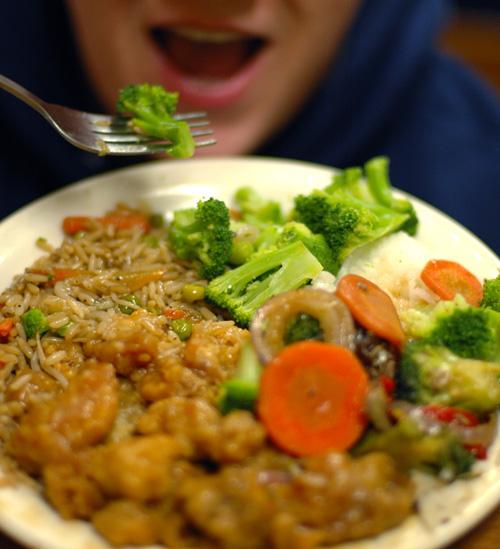Find out what’s in your meals

Nutritional information and portion sizes are written on the buffet island in the Gregory dining hall on Thursday in an effort to increase awareness about food. Most students said the information was helpful in making healthy choices for meals. Photo Illustration by Ned Mulka
February 11, 2009
It may be a bit disheartening to see how much fat the waffle fries have, but lo and behold, the sad truth is out for all to see.
University Dining is posting limited nutrition information next to selected items in dining halls in an attempt to increase student awareness and wellness this semester.
In the past, nutrition information has been posted online through EatSmart, an application available on the University Housing’s Web site. Now, the information is located much closer: right above or next to the food.

“We like our customers to be able to have as much information as possible to make choices that work for them,” said Kirsten Ruby, assistant director of housing for marketing.
“Part of that is the online EatSmart system, but we also know that customers aren’t always at a computer.”
Get The Daily Illini in your inbox!
Lauren Waller, junior in LAS, said she found the new system more helpful.
“They always had it on the Internet,” she said. “But not everyone really, before they eat, wants to map out what they’re going to eat, how much they’re going to eat.”
Robbe Burton, freshman in LAS, said she was surprised by some of the information – like the calorie count for Alfredo sauce, which has 216 calories from fat and 24 total grams of fat. She said she thinks putting it up helps her make good choices.
“Before they put the calorie count, it’s been harder to tell what exactly you’re doing,” she said. “Then, when you actually have it, you’re more inclined to pick healthy things.”
Waller said she was sometimes frustrated by the lack of healthy options besides the perpetual salad bar. However, Marc Maybaum, sophomore in LAS, said he feels he has enough options to make good choices.
Maybaum said he can always fall back on fruit, granola and yogurt if he does not like the hot options being offered. He said he gained 10 pounds his freshman year and thinks the new way of displaying information will help new students be informed about the food they eat.
“It’s nice to know, so at least you get to watch and understand what you’re taking in,” he said.
The University is also offering Wellness Wednesdays, including seminars, nutritional advice and free wellness checkups, at the Activities and Recreation Center every first and third Wednesday this semester. A Wellness Competition for students in residence halls has also started this semester, Ruby said.
Leia Kedem, graduate student, offered students general advice on nutrition and assisted with checkups at the most recent Wellness Wednesday. She said living in a residence hall can make eating healthy difficult.
“It’s hard in the dorms to kind of monitor yourself because all of a sudden you’re in a new environment, and there’s endless amounts of food, and it’s hard because someone’s not telling you what to eat, when to eat,” she said.
“You have so much freedom, and it’s hard to put a limit on yourself.”
Ruby said the University tries to offer students healthy options and information, but ultimately, the choice is theirs.
“We provide a lot of choices at every meal, so residents who are choosing to eat in a more healthy way should have ample opportunity to do so,” she said.
The University reviews its menus each semester. Ruby said they try to find a balance between what students are asking for and what they are taking, as well as offering choices to make everyone happy.
“Chicken fingers might not be the best choice for everybody all of the time, but students like them,” she said.






